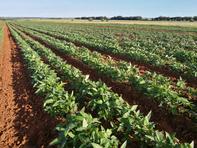Cowpeas (Vigna unguiculata) is indigenous to Africa and is planted for human consumption and animal fodder. Its seeds, pods and leaves are commonly used as human food. Cowpeas are also known as swartbekboontjie (Afrikaans), dinawe (Ndebele), dinaba (Shangaan), imbumba (Zulu), monawa or nawa (Pedi) and dinawa (Tswana).

Depending on the variety used, cowpeas may be climbing and erect (such as Dr Saunders) or creeping (such as Bechuana White). The climbing type is better suited for forage or as cover crop.
Cowpeas can be planted as an intercrop or in rotation and can tolerate drought. It is a protein-rich bean crop which leaves nitrogen in the soil so it benefits the follow-up crop. It is estimated that the annual world cowpea crop is about 12,5 million ha of which the total grain production (for food) is 3 million tons.
West and Central Africa are the leading cowpea producing regions in the world producing 64% of the estimated 3 million tons of cowpea seed.
Nigeria is the world’s leading cowpea producing country, followed by Brazil. In Australia and Asia cowpeas are primarily planted for fodder but also as a cover crop or as green manure to enrich the soil with nitrogen and nitrogen-fixing microbes. In South Africa cowpeas are produced in the North West, Limpopo, KwaZulu-Natal and Mpumalanga provinces.
Eating Cowpeas
Cowpeas can be cooked or either steamed after soaking in water overnight. It is then cooked with other vegetables to make a thick soup, or ground into a meal or paste. Fresh, immature pods may be boiled as a vegetable.
The leaves and growth points can be picked and used as a vegetable dish similar to spinach, but it can also be dried and used as a protein substitute.
The green seeds are sometimes roasted like peanuts, ground and then used as a substitute for coffee. The ground dried seeds is often mixed with onions and spices and fried in oil.
In Limpopo and Mpumalanga provinces cowpea leaves are harvested fresh as a vegetable for soup preparation or dried for later use. Cowpeas are high in iron (Fe), potassium (P), vitamin B9, it is rich in fiber, protein (up to 24%), low in fat and high in various amino acids.
Cowpeas for Animal Feed
Cowpeas are also planted as animal feed - such as hay production and to make silage. Silage is preserved animals feeds, ideal for use during droughts. Cowpea silage is made by using cowpea leaves mixed with the green leaves of maize or sorghum and then compacting the green matter, covering it with plastic and weighing it down to make it airtight. It is then left to ferment.
Cowpeas can produce good yields of high-quality dry matter. Under dryland conditions, yields of cowpea forage 2 to 3 ton of dry matter/ha, but yields of up to 8 t DM/ha that have been recorded in irrigated areas.
The best feeding value for animals can be obtained in stands where cowpeas were intercropped with maize. The aboveground plant parts of cowpea, except the pods, are utilised as animal fodder. Local farmers who cut and store cowpea fodder during the dry season can make as much as 25% of their annual income by selling it as fodder.
By Marinda Louw